|
The Keeper of the Keys
by Bob Brooke
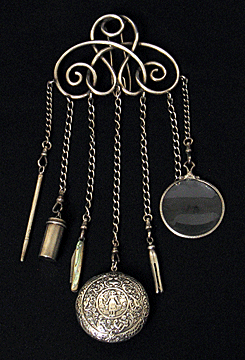 During
Victorian times, many women, either mistresses of the house or
housekeepers in large mansions, who were in charge of keeping the keys
to doors, drawers, and cabinets, wore a decorative belt hook with a
series of chains suspended from it, called a chatelaine at their waist.
Household items, including a small pair of scissors, a thimble, a
pendant watch, a vinaigrette (to use in case someone fainted), a stamp
holder, a match safe, and a household seal, hung from the chains. But
the most important items hanging from the chatelaine were the keys
needed by the person who managed the household. During
Victorian times, many women, either mistresses of the house or
housekeepers in large mansions, who were in charge of keeping the keys
to doors, drawers, and cabinets, wore a decorative belt hook with a
series of chains suspended from it, called a chatelaine at their waist.
Household items, including a small pair of scissors, a thimble, a
pendant watch, a vinaigrette (to use in case someone fainted), a stamp
holder, a match safe, and a household seal, hung from the chains. But
the most important items hanging from the chatelaine were the keys
needed by the person who managed the household.
The name chatelaine comes from the French term châtelaine, first
used disparagingly because it referred to a device designed to have all
the tools necessary for the woman of the household to sort out any
problem she might encounter during the day, like a fraying curtain.
Women as far back as ancient Rome wore chatelaines from which hung ear
scoops, nail cleaners, and tweezers. Women in Roman Britain wore
“chatelaine brooches” from which they hung toilet sets.
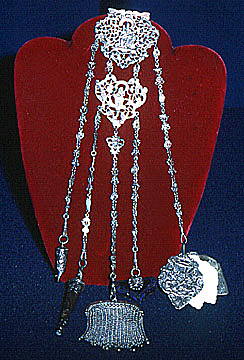 Clothes
didn’t have pockets, or not ones big enough to hold much and purses if
carried were small. The Chatelaine kept a woman’s necessities together
and available at all times. There were Chatelaines for sewing and some
for writing and some plainer ones that held keys or coins. Clothes
didn’t have pockets, or not ones big enough to hold much and purses if
carried were small. The Chatelaine kept a woman’s necessities together
and available at all times. There were Chatelaines for sewing and some
for writing and some plainer ones that held keys or coins.
The chatelaine became a status symbol for women in the 19th century. The
woman who held the keys to all the many desks, chest of drawers, food
hampers, pantries, storage containers, and many other locked cabinets
was "the woman of the household." As such, she was the one who gave
directions to the servants, housemaids, cooks and delivery servicemen.
She would also open or lock the access to the valuables of the house.
Frequently, the woman who wore the chatelaine was the senior woman of
the house. When a woman married a son and moved into his father's house,
the son's mother would usually hold on to the keys. However, if the
mother became a widow, the keys and their responsibilities and status
became the responsibility of the eldest son's wife.
Younger women and daughters in the house, who wanted it to appear as if
they had this responsibility, would often wear an intricate chatelaine
without the keys, but with a variety of other objects. Instead of the
keys, they attached bright and glittering objects, which she could use
to start a conversation. If there wasn’t a woman of the house, the
person who’s responsibility it was to hold the keys was often a hired
housekeeper.
Craftsmen used gold or silver to fashion most chatelaines. Some had
beautiful intricate vitreous enamel decorations. Most chatelaines were
between 8 and 13inches long and between 2 and 3 inches wide.
While women purchased complete chatelaines, they often would buy other
objects to hang on them, perhaps while traveling, much like charms on a
charm bracelet.
 One
of these objects was the vinaigrette bottle. These came in a variety of
colors and designs, including ruby red glass, covered with a gilt brass
casing, decorated with birds or flowers. These little bottles had hinged
gilt lids which closed tightly. Women used them to recover from fainting
spells—a malady in Victorian times. One
of these objects was the vinaigrette bottle. These came in a variety of
colors and designs, including ruby red glass, covered with a gilt brass
casing, decorated with birds or flowers. These little bottles had hinged
gilt lids which closed tightly. Women used them to recover from fainting
spells—a malady in Victorian times.
A variation of the viniagrette was the scent/perfume bottle. Many people
think these are scent bottles for perfume, and women used them for that
as well. But many ladies had a scent bottle on their sewing Chatelaine's
to store clean water in so they could clean the tips of their fingers to
keep the garment or quilt clean that they were working on. Some small
etui's have little glass bottles on the inside that held clean water.
Remember, at that time there weren't sinks everywhere in which women
could wash their hands.
Sewing Chatelaines
Beside the household chatelaine described above, women also had
specialized chatelaines. The one most used was a sewing chatelaine. On
its chains hung items that would help the owner with sewing chores.
Often craftsmen made these of European silver which has 800 parts silver
and is stronger than sterling which has 925 parts silver, thus making it
softer.
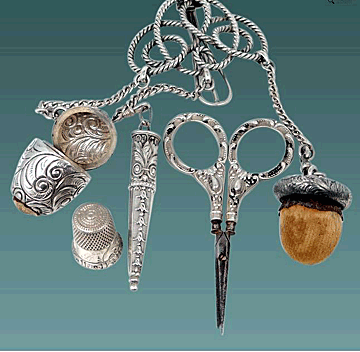 On
one of the chains hung an Etui, a small box on which would have been
decorated with perhaps rural scenes or floral designs which could hold
pins or other sewing necessities. On
one of the chains hung an Etui, a small box on which would have been
decorated with perhaps rural scenes or floral designs which could hold
pins or other sewing necessities.
On two of the other chains hung a large and a small needle holder. These
may have been decorated with a repoussé of small animals or plants. Some
needle holders had the shape of fruits, such as strawberries, and were
about one and half to three inches long.
Another chain held a sterling hinged thimble holder with an emery tip
and a sterling silver size 9 thimble inside. Yet another held a Gorham
sterling silver scissor case with sterling handled scissors and sterling
capped acorn shaped emery. The sewing chatelaine also included a small
notebook and a retractable pencil, and it might also include a round
pincushion between two disks.
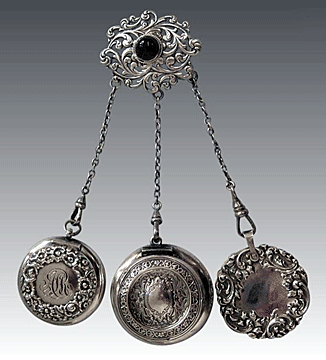 A
common motif was gardening, with baskets of flowers by gardening tools,
as well as swags and bows. The pincushion has a garland of flowers,
which matches all the flowers on the decorative swags. A
common motif was gardening, with baskets of flowers by gardening tools,
as well as swags and bows. The pincushion has a garland of flowers,
which matches all the flowers on the decorative swags.
Dance Chatelaines
Some women wore a special chatelaine when they went to parties or went
dancing. Dangling from its chains was a small container holding face
powder, a small mirror, and a small notebook and pencil for jotting down
names and addresses of people she met. It might even have had a tiny
photograph album containing four photos of her family which she could
show to other guests.
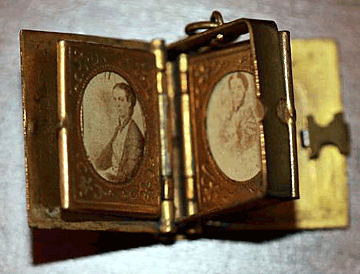 Photo
Album Photo
Album
Another item that often hung from a chatelaine in the late 19th century
was a small metal notebook with little holders on the side for the
original pencil. Removing the pencil and opening the notebook, accordion
style, reveals 10 tiny pictures. Bows and flowers impress one side of
the notebook, the other has a family crest.
< Back to Collectibles Archives
Next Article >
|
